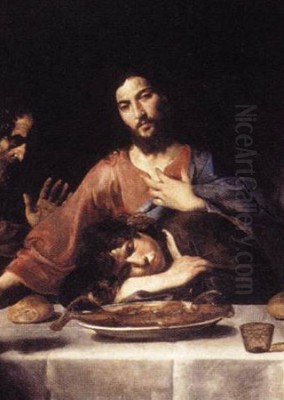
Valentin de Boulogne, born Jean Valentin (1591 – 19 August 1632), stands as one of the most compelling and significant French painters of the Baroque era. Though his life was tragically short, his artistic output, deeply rooted in the revolutionary naturalism of Caravaggio, carved a distinct and influential path in the vibrant artistic milieu of early 17th-century Rome. His work is characterized by its dramatic use of light and shadow (tenebrism), profound psychological insight, and an unflinching depiction of both sacred narratives and the gritty realities of everyday life. Valentin was not merely an imitator; he absorbed the Caravaggesque idiom and infused it with a unique sensibility, marked by a melancholic grandeur and a sophisticated understanding of human emotion.
Early Life and Artistic Genesis
Jean Valentin, who would later be known almost exclusively by his first name or as Valentin de Boulogne (a reference to Boulogne-sur-Mer, though he was born in Coulommiers, Brie, in the Île-de-France region), entered the world in 1591. His father, also named Valentin, was a painter and glazier, and it is highly probable that the young Valentin received his initial artistic training within the paternal workshop. The family had been established in Coulommiers since at least 1489, suggesting a lineage with some local standing.
Details of his early artistic education in France remain somewhat obscure. While his father's instruction would have provided a foundational understanding of painting techniques, the specific masters or artistic currents that shaped him before his departure for Italy are not definitively known. However, the artistic landscape of France at the turn of the 17th century was still largely influenced by the late Mannerist style, with artists like Martin Fréminet and Georges Lallemant active. It is plausible that Valentin was exposed to these trends, but his mature style would ultimately diverge significantly, aligning him with the more radical developments occurring south of the Alps.
The Roman Crucible: Arrival and Immersion
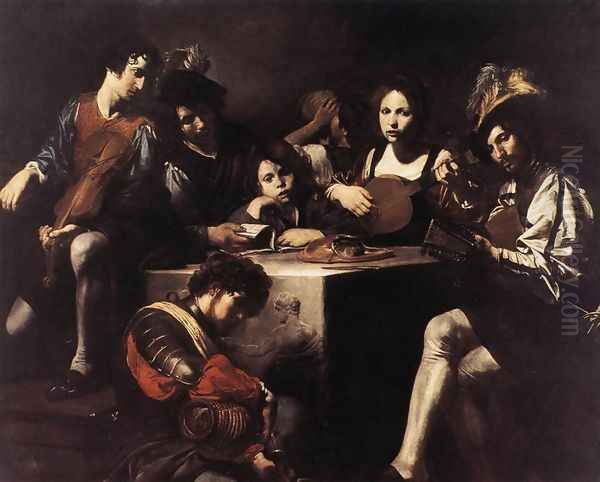
Around 1613 or 1614, Valentin made the pivotal decision to travel to Italy, the ultimate destination for ambitious artists of his generation. Rome, in particular, was a magnet, a city teeming with ancient ruins, Renaissance masterpieces, and, crucially for Valentin, the lingering, potent influence of Michelangelo Merisi da Caravaggio. Though Caravaggio himself had fled Rome in 1606 and died in 1610, his revolutionary approach to painting – his dramatic chiaroscuro, his use of live models often drawn from the common people, and his intense, unidealized naturalism – had irrevocably altered the course of art.
Upon his arrival, Valentin would have encountered a thriving community of artists, both Italian and foreign, who were grappling with Caravaggio's legacy. These painters, often referred to as Caravaggisti, adopted and adapted aspects of the master's style. Among the most prominent was Bartolomeo Manfredi, an Italian painter who played a crucial role in codifying and popularizing Caravaggio's thematic repertoire, particularly scenes of tavern life, musicians, cardsharps, and fortune-tellers. Manfredi's "Manfrediana Methodus" (Manfredi's method) became a significant conduit for the dissemination of Caravaggesque themes and compositions, and Valentin is widely considered to have been profoundly influenced by him, perhaps even working in his circle for a time.
Other notable Caravaggisti active in Rome during Valentin's early years included the Spaniard Jusepe de Ribera (before his move to Naples), and Italian painters like Orazio Gentileschi and his daughter Artemisia Gentileschi, as well as Carlo Saraceni. The French contingent was also growing, with Simon Vouet arriving in Rome around the same time as Valentin. Vouet, initially a fervent Caravaggist, would later evolve towards a more classical and decorative Baroque style, but his early Roman works share affinities with Valentin's.
The Bentvueghels and the Artistic Community
Valentin quickly integrated into the bohemian artistic life of Rome. He became associated with the Bentvueghels (Dutch for "birds of a feather"), a society of mostly Dutch and Flemish artists known for their convivial, often riotous, gatherings and their resistance to the academic strictures of the Accademia di San Luca. Members of the Bentvueghels would adopt nicknames, or "bentnames," and Valentin was reportedly known as "Amador" (lover) or "Innamorato," perhaps reflecting his passionate nature or the themes in his art.
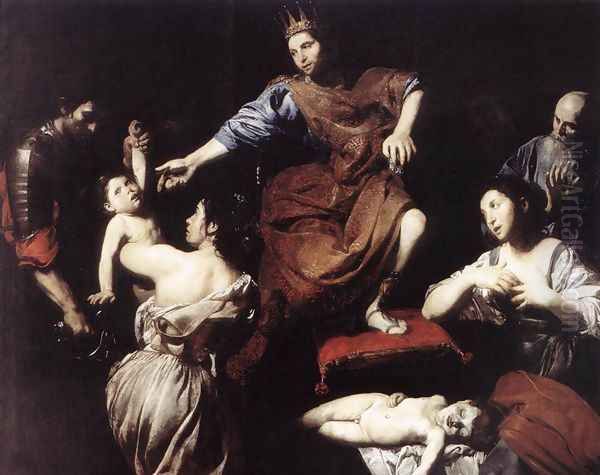
This association placed him in the company of artists like Cornelis van Poelenburgh, Bartholomeus Breenbergh, Dirck van Baburen, and Gerrit van Honthorst, the latter two being key figures of the Utrecht Caravaggisti who brought a distinct Northern European sensibility to Caravaggio's style. While the Bentvueghels were known for their revelry, they were also a serious artistic network, providing support and fostering a sense of shared identity among foreign artists in Rome. Valentin's interactions within this group, and with other French artists like Nicolas Régnier and Nicolas Tournier, who also worked in a Caravaggesque vein, would have further shaped his artistic development and provided a competitive yet collegial environment.
The Quintessence of Valentin's Style
Valentin de Boulogne's art is a powerful synthesis of Caravaggio's dramatic realism and his own unique artistic personality. His style is characterized by several key elements that distinguish him even within the Caravaggesque movement.
Tenebrism and Dramatic Illumination
Like Caravaggio, Valentin was a master of tenebrism, the use of strong contrasts between light and dark to model figures and create dramatic intensity. Light in his paintings often emanates from an unseen source, raking across figures, illuminating faces, hands, and key details while plunging backgrounds and less important areas into deep shadow. This technique not only creates a sense of three-dimensionality but also heightens the emotional impact of his scenes, focusing the viewer's attention and imbuing his subjects with a palpable presence. His shadows are not merely absences of light but active compositional elements, often rich and velvety, contributing to the overall mood of his works.
Unflinching Naturalism and Psychological Depth
Valentin’s commitment to naturalism was profound. He painted directly from life, and his figures, whether saints, soldiers, or musicians, possess a striking verisimilitude. He did not shy away from depicting the imperfections of his models – their weathered skin, their unkempt hair, their individualized features. This naturalism extended to the depiction of textures: the gleam of armor, the softness of velvet, the roughness of peasant cloth, the coolness of stone.
Beyond mere physical likeness, Valentin excelled at conveying the inner lives of his characters. His figures are rarely impassive; their faces and gestures communicate a wide range of emotions – contemplation, sorrow, cunning, weariness, or intense concentration. He had a particular gift for capturing moments of quiet introspection or poignant melancholy, even amidst scenes of revelry or violence. This psychological acuity lends his paintings a depth and humanity that resonates with viewers.
Themes: The Sacred and the Profane
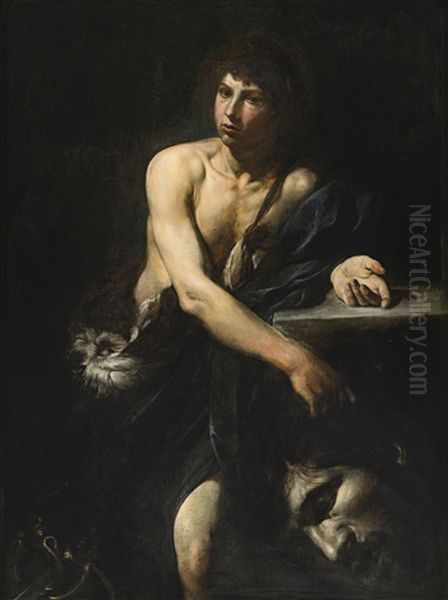
Valentin’s thematic range encompassed both religious subjects and genre scenes, often blurring the lines between the two. His religious paintings, such as Christ Driving the Merchants from the Temple or The Denial of Saint Peter, are rendered with the same earthy realism as his secular works. Biblical figures are depicted as ordinary people caught in extraordinary circumstances, making their spiritual struggles and triumphs all the more relatable.
His genre scenes, heavily influenced by Manfredi, often depict musicians, drinkers, soldiers, fortune-tellers, and cardsharps. These paintings, set in dimly lit taverns or ambiguous interiors, are not simply picturesque portrayals of low life. They often carry moralizing undertones, exploring themes of transience, deception, and the follies of humankind. Yet, they are also imbued with a sense of camaraderie and a melancholic beauty, reflecting perhaps Valentin's own experiences and observations of Roman life. He often included self-portraits within these group scenes, further personalizing his engagement with these subjects.
Key Commissions and Patronage
Despite his bohemian lifestyle, Valentin achieved considerable recognition during his lifetime and secured important commissions. His talent did not go unnoticed by influential patrons. Among his most significant supporters was Cardinal Francesco Barberini, nephew of Pope Urban VIII. For the Barberini family, Valentin executed several important works, including the monumental Allegory of Italy (also known as Allegory of Rome), a complex and ambitious painting that showcased his ability to handle large-scale compositions with allegorical depth.
Perhaps his most prestigious commission came through the Barberini, for an altarpiece in St. Peter's Basilica: The Martyrdom of Saints Processus and Martinian. To receive a commission for St. Peter's was a mark of high esteem, placing Valentin in the company of the most celebrated artists in Rome. This powerful and dramatic work, completed around 1629-1630, demonstrates his mastery of complex figural arrangements and his ability to convey intense emotion on a grand scale. It hung opposite Nicolas Poussin's Martyrdom of St. Erasmus, creating a fascinating dialogue between two leading French painters in Rome, one a champion of Caravaggism, the other of a burgeoning classicism.
Other patrons included Cassiano dal Pozzo, a renowned scholar and collector who also patronized Poussin, and Fabrizio Valguarnera, a Sicilian nobleman and art dealer with a penchant for Caravaggesque paintings. These connections indicate that Valentin was well-regarded in sophisticated artistic and intellectual circles.
Masterpieces and Signature Works
Valentin de Boulogne's oeuvre, though not vast due to his short career (around 75 paintings are generally attributed to him), contains numerous masterpieces that exemplify his unique style.
The Fortune Teller with Soldiers (c. 1620s)

This subject, popularized by Caravaggio and Manfredi, was a favorite of Valentin. Versions exist in several museums, including the Toledo Museum of Art and the Musée du Louvre. These paintings typically depict a group of soldiers and young men gathered around a gypsy fortune teller. While one young man has his palm read, often with an expression of naive credulity, another figure, sometimes an accomplice of the fortune teller, may be shown picking his pocket. The scene is a study in human psychology: the cunning of the fortune teller, the gullibility of youth, the watchfulness of companions. Valentin masterfully uses expressions and gestures to tell the story, all set within his characteristic dramatically lit interior.
The Concert (or Musicians and Drinkers) (various versions, c. 1620s)
Valentin painted numerous concert scenes, often featuring himself among the figures. Works like The Concert with a Bas-Relief (Louvre) or The Musical Party (Los Angeles County Museum of Art) depict groups of musicians playing lutes, violins, and other instruments, often accompanied by drinkers. These scenes are more than just depictions of revelry; they often carry a melancholic air, a sense of vanitas, hinting at the fleeting nature of pleasure and life itself. The figures are intensely individualized, their gazes often introspective, even when engaged in communal activity. The play of light on instruments, faces, and rich fabrics is rendered with exquisite skill.
The Martyrdom of Saints Processus and Martinian (c. 1629-30)
Created for St. Peter's Basilica and now in the Pinacoteca Vaticana, this is one of Valentin's most significant public commissions. The painting depicts the brutal martyrdom of two Roman soldiers who were jailers of Saints Peter and Paul and were converted by them. Valentin's composition is dynamic and emotionally charged, with the saints' suffering rendered with stark realism. The dramatic lighting and the powerful physicality of the figures make this a compelling example of High Baroque religious art in the Caravaggesque tradition. It stands as a testament to his ability to handle monumental religious narratives with profound pathos.
The Judgment of Solomon (c. 1620s)
Housed in the Musée du Louvre, this painting tackles a classic biblical story demanding psychological insight. Valentin focuses on the dramatic moment of Solomon's decree. The anguish of the true mother, the deceit of the false one, and the wisdom of Solomon are powerfully conveyed through expressions and gestures. The composition is carefully structured, with light and shadow used to highlight the key protagonists and heighten the tension of the scene. It showcases Valentin's skill in narrative painting and his ability to imbue traditional subjects with fresh emotional intensity.
David with the Head of Goliath (c. 1620-1622)
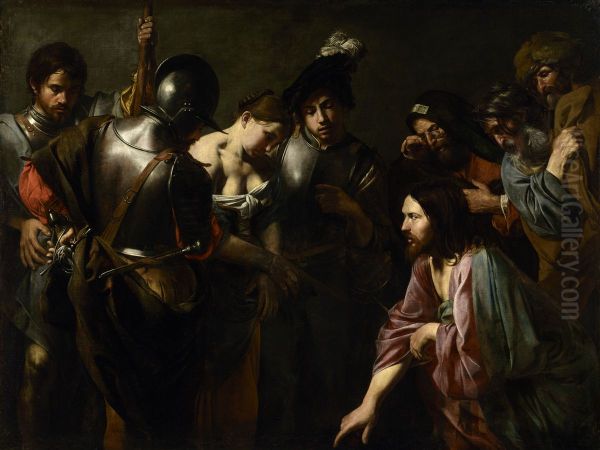
This subject, also famously treated by Caravaggio, allowed Valentin to explore themes of triumph, vulnerability, and introspection. In his version (e.g., Thyssen-Bornemisza Museum, Madrid), David is often depicted not as a purely heroic figure but as a youth burdened by the gravity of his act. The severed head of Goliath is rendered with gruesome realism, while David's expression is often melancholic or contemplative. The strong chiaroscuro emphasizes the sculptural quality of the figures and the dramatic intensity of the moment.
The Denial of Saint Peter (c. 1620s)
Another popular Caravaggesque theme, Valentin’s interpretations (e.g., Fondazione di Studi di Storia dell'Arte Roberto Longhi, Florence) capture the intense psychological drama of Peter's betrayal. The accusing servant girl, the surrounding soldiers, and Peter's anguished denial are set in a dimly lit space, the flickering light of a candle or brazier often providing the sole illumination, heightening the sense of conspiracy and inner turmoil.
Saint John the Baptist (c. 1620s)
Valentin's depictions of Saint John the Baptist (e.g., Santa Maria in Via, Camerino; Capitoline Museums, Rome) often show the saint in a wilderness setting, clad in animal skins, his expression one of intense spiritual contemplation. These works highlight Valentin's ability to convey profound spirituality through a robust, naturalistic style. The strong modeling of the saint's physique and the focused intensity of his gaze are characteristic.
Allegory of Italy (or Allegory of Rome) (c. 1628-1629)
Painted for the Barberini family (Finnish National Gallery, Helsinki), this complex allegorical work features figures representing Rome, the Tiber River, and other symbolic elements. It demonstrates Valentin's ambition and his capacity to engage with the more intellectual and classicizing currents of Roman art, while still retaining his signature Caravaggesque power.
A Life of Passion and an Untimely Demise
Contemporary accounts, notably by Joachim von Sandrart and Giovanni Baglione (two artist-biographers who knew Valentin), paint a picture of a man who lived life intensely. He was known for his love of wine, tobacco, and good company, and his lifestyle was often described as dissolute or bohemian. Sandrart mentions his penchant for garlic and wine, and his participation in the often rowdy gatherings of the Bentvueghels.
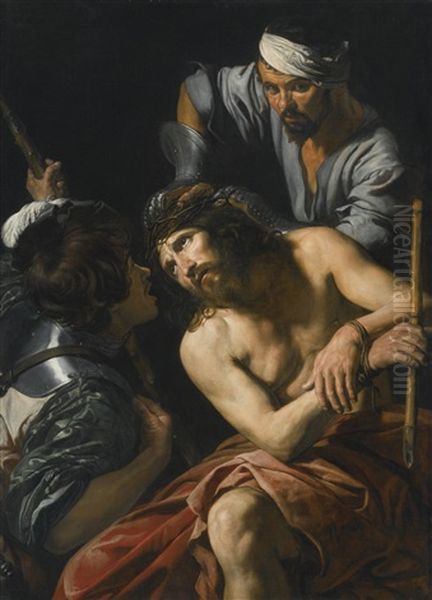
This passionate, perhaps reckless, approach to life ultimately contributed to his early death. According to Baglione, in the summer of 1632, after an evening of excessive drinking and smoking, Valentin, feeling overheated, plunged himself into the cold waters of the Fontana del Tritone (though some sources say a fountain near the Fortuna Virilis). He subsequently contracted a raging fever and died a few days later, on August 19, 1632, at the age of only forty-one. He was buried in the church of Santa Maria del Popolo. His death cut short a career that was at its peak, depriving the art world of a truly original talent.
Legacy and Enduring Influence
Despite his premature death, Valentin de Boulogne's impact was significant. In his time, he was considered one of the foremost painters in Rome, and his works were highly sought after by collectors. His paintings were admired for their powerful naturalism, their emotional depth, and their technical brilliance. French King Louis XIV, a discerning collector, owned several of Valentin's works, which are now highlights of the Louvre's collection.
Valentin's influence can be seen in the work of other Caravaggesque painters, both French and Italian. He, along with Manfredi, was instrumental in perpetuating and popularizing Caravaggio's themes and style, ensuring their continued relevance well into the 17th century.
After a period of relative obscurity following the decline of Caravaggism's popularity, Valentin's reputation was revived in the 19th century. Realist painters like Gustave Courbet and Édouard Manet found inspiration in the unvarnished naturalism and dramatic compositions of Baroque masters like Valentin and Ribera. Manet, in particular, seems to have studied Valentin's work, and echoes of his compositions and lighting can be found in Manet's paintings.
Valentin in Museum Collections
Today, Valentin de Boulogne's paintings are prized possessions of major museums around the world. The Musée du Louvre in Paris holds the most extensive collection, including masterpieces like The Judgment of Solomon, The Concert with a Bas-Relief, The Fortune Teller, and The Four Ages of Man.
Other significant holdings can be found in:
The Pinacoteca Vaticana, Rome (The Martyrdom of Saints Processus and Martinian)
The Metropolitan Museum of Art, New York (The Denial of Saint Peter, Musicians and Soldiers)
The National Gallery of Art, Washington D.C. (Soldiers Playing Cards and Dice (The Cheats))
The J. Paul Getty Museum, Los Angeles (Christ and the Adulteress)
The National Gallery, London (The Four Ages of Man)
The Thyssen-Bornemisza Museum, Madrid (David with the Head of Goliath)
The Capitoline Museums, Rome (Saint John the Baptist)
The Finnish National Gallery, Sinebrychoff Art Museum, Helsinki (Allegory of Italy)
The Cleveland Museum of Art (The Repentant Magdalen)
The Indianapolis Museum of Art (The Crowning with Thorns)
Numerous other museums in Europe and North America also house important examples of his work.
Art Historical Reassessment and Contemporary Scholarship
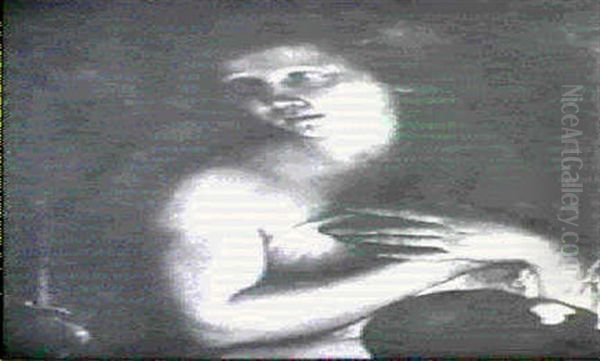
In recent decades, Valentin de Boulogne has been the subject of renewed art historical attention. Major exhibitions, such as "Valentin de Boulogne: Beyond Caravaggio," held at the Metropolitan Museum of Art, New York, and the Musée du Louvre, Paris, in 2016-2017, have brought his work to a wider audience and solidified his reputation as a major figure of the Baroque period.
Scholarly research has delved deeper into his life, his relationship with patrons and fellow artists, and the nuances of his style. Art historians now recognize him not just as a follower of Caravaggio, but as an artist who forged a highly personal and expressive interpretation of the Caravaggesque aesthetic. His ability to combine raw naturalism with a sense of classical grandeur, his psychological acuity, and his mastery of composition and light are increasingly appreciated. He is seen as arguably the greatest French Caravaggesque painter and one of the most original artistic voices in Rome during the 1620s.
Conclusion: The Enduring Power of a Baroque Master
Valentin de Boulogne's art continues to captivate viewers with its dramatic intensity, its profound humanity, and its technical brilliance. In a career that spanned less than two decades in Rome, he produced a body of work that stands as a powerful testament to the enduring appeal of Caravaggio's revolution, while also asserting his own distinct artistic identity. His figures, whether saints or sinners, heroes or common folk, emerge from the shadows with a startling immediacy, their faces etched with the complexities of human experience. Valentin's ability to convey deep emotion, to tell compelling stories, and to capture the raw beauty of the world around him ensures his place as a pivotal and deeply moving master of the Baroque age. His legacy is that of an artist who, with uncompromising honesty and profound empathy, explored the light and darkness of both the human form and the human spirit.